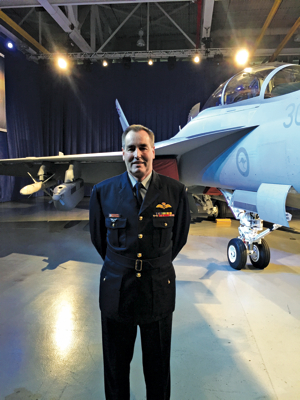The RAAF's first EA-18G Growler has been handed over in a ceremony at Boeing's St. Louis facility. Destined for 6 Squadron, the aircraft is the first of 12 Growlers to complement 24 Super Hornets already in service. All 12 aircraft are due to be in country by the end of 2017.
Katherine Ziesing | St Louis, US
“The Growler is leading technology edge that the RAAF strives to maintain,” Air Marshal Geoff Brown said, speaking at the ceremony on behalf of new RAAF chief Air Marshal Leo Davies. “This is the biggest advance in technology the RAAF has seen since the introduction of the F-111.”
The FMS contract for the Growlers was signed in June 2014, with the USN giving up spots on the production line to ensure quicker availability for the RAAF.
While many of the electronic attack capabilities offered by the Growler are classified, both operators in the USN and RAAF are quietly confident of its abilities. USN experience in Libya recently demonstrated that the non-kinetic effects offered by the Growler were 'highly effective' with AIRMSHL Brown confirming the information sharing of lessons learned between the USN and RAAF is well and truly in place. As the RAAF gains experience with the Growler, he hopes that the lessons learned sharing will be much more of a two way street.
This first Australian Growler will fly to NAS China Lake, California, for flight testing. This will be followed by a trip to NAS Whidbey Island, Washington, where Australian pilots will train alongside US Navy aviators. The testing will include work with the AT-FLIR, Boeing’s head of F/A-18 and EA-18 Program Manager Dan Gillian said.
The aircraft is in the same USN configuration, but with the addition of the ATFLIR. The USN is still looking into this sensor given their experience in Libya and Syria where it would have come handy.
“The USN is considering incorporating the FLIR into its configuration,” Rear Admiral Donald Gaddis, the USN’s program executive officer for tactical aircraft said at the roll-out ceremony. “One of the big lessons out of Libya was the need to have an electro-optical pod on the platform itself.”

Former Chief of Air Force AIRMSHL Geoff Brown at the roll out ceremony in St. Louis. Credit: ADM Katherine Ziesing
This first RAAF aircraft will ferry to Australia in 2017 along with its counterparts that will be stored in the US until delivery. As Australia’s first electronic attack aircraft, RAAF Growler air crews have been training on the mission with their American counterparts for the last 18 months. Six aircrews already are operating with USN crews to gain experience, AIRMSHL Brown said.
“We’ve got air crews already with USN squadrons that are operating out of Japan at the moment. They’ve already become established inside those USN squadrons how to use those aircraft,” AIRMSHL Brown told reporters. “The Growler is such a big change and it gives us so many more options than we’ve ever had before. In many respects, it is the final piece of the jigsaw puzzle for the RAAF.”
Australia also is likely to be key for US operations in the Pacific region.
“It is my belief that the USN planners in the Pacific are counting on the Australians and their air force to be a part of whatever contingency may come up,” RADM Gaddis said.
In terms of costs, according to the latest ANAO Major Projects Report, the Growler program is worth $3 billion under program Air 5349, encompassing a range of FMS cases for sustainment, weapons and sensors. The $3.7 billion figure seen in relation to the program comes from an initial FMS case where not all options were exercised.
AIRMSHL Brown confirmed that the RAAF is aiming to keep the same configuration as the USN, with the pair acting as their own mini user group for future requirements and upgrades. There is every chance the Growler and Super Hornet will benefit from future US programs like the Next Generation Jammer to replace Raytheon’s ageing ALQ-99 system.
Boeing is also looking at keeping the Super Hornet line going for as long as possible. Boeing head of program Dan Gillian confirmed that production is dropping from four to two aircraft a month. With current orders, the line will run out of work at the end of 2017. Boeing is hoping that possible competitions in Denmark and Kuwait could keep the line at St Louis open until the end of 2019. The site has competed for work on the commercial side of the house, winning work from its sister commercial division for work on the 737, the same line that produces the P-8.
Disclaimer: Katherine Ziesing travelled to St Louis as a guest of Boeing.



